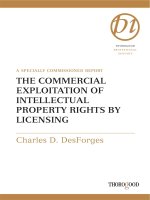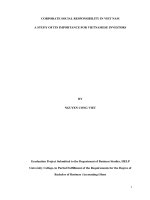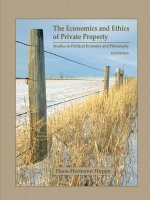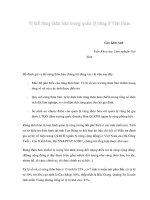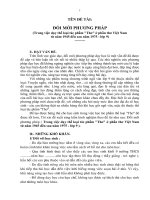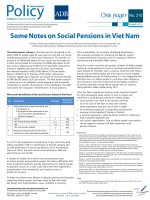North versus south the impact of social norms in the market pricing of private property rights in viet nam
Bạn đang xem bản rút gọn của tài liệu. Xem và tải ngay bản đầy đủ của tài liệu tại đây (435.28 KB, 43 trang )
North versus South:
the impact of social norms in the market pricing of
private property rights in Vietnam
an article later published in
World Development
June 28, 2007
By
Annette M. Kim
Department of Urban Studies and Planning
Massachusetts Institute of Technology
77 Massachusetts Avenue
Room 9-539
Cambridge, MA 02139
Email:
Electronic
Electroniccopy
copyavailable
availableat:
at: /> />
North versus South:
the impact of social norms in the market pricing of
private property rights in Vietnam
Summary:
Despite a centralized political system, nation-wide legal reforms, and similar high
housing demand pressures, property rights have evolved differently in Vietnam’s two
leading cities Hanoi and Ho Chi Minh City during the transition period. Using
ethnographic fieldwork and a hedonic price model, the study shows that the two land and
housing markets price tenure ambiguity differently. The different price structures
indicate the importance of norms, as socially constructed by local political interests and
culture, in the efficacy of land title regularization programs.
Key words: Asia, Vietnam, property rights, housing market, social norms, land tenure
Electronic
Electroniccopy
copyavailable
availableat:
at: /> />
Acknowledgements
This study benefited from the financial assistance of the Fulbright Commission, the
Lincoln Institute of Land Policy, the World Bank, and M.I.T.’s Humanities and Social
Sciences grant. Many people assisted the fieldwork, but this study would not have been
possible without the help of Le Thi Thanh Loan at the Statistical Office of Ho Chi MInh
City and field assistants Le Tuyen and Huong Giang Le Nguyen. In addition, colleagues
Lawrence Susskind, Lynn Fisher, and colleagues in the Comparative Law and Economics
Group, in particular Katharina Pistor and Susan Rose-Ackerman, gave helpful comments
in the development of this article. However, all the views expressed are solely those of
the author.
Electronic copy available at: />
1. INTRODUCTION:
For decades, international development agencies and governments have pursued land
tenure regularization projects in hopes of bolstering private property rights enough to unleash
wealth generating investment into land and housing markets. Their record of success has been
mixed and often criticized (Durand-Lasserve & Royston, 2002; Field & Torero, 2004; FirminSellers & Sellers, 1999; Payne, 2001; Woodruff, 2001). However, the support for these
programs by many has not flagged but only strengthened in recent years (deSoto, 2000)1.
Previous scholarship has tried to account for the mixed outcomes by debating the
relationship between tenure security and legal titles. In some contexts, the impact of title
programs may be limited because households invest in property without title in hopes of having
stronger claims for tenure later (Razzaz, 1993). Alternatively, it could be that the efficacy of title
is unrealized without also strengthening legal enforcement and financial institutions
(McKechnie, 2005). Others point out that in some established communities, the untitled might
actually feel quite secure about their housing tenure but still do not choose to participate in the
real estate market (Lanjouw & Levy, 2002). Most developing and transition countries exhibit a
range of title formalization and market development even without fully developed courts and
financial institutions (Li, 1999; Zhu, 2002). Irregularity of titles appears to be a hindrance in
some markets more than others.
The classic theory for explaining the evolution of legal private property rights systems
counted the costs and benefits (Demsetz, 1967). The market would create the demand for title if
a sufficiently large net economic gain could be generated by such a change. However, there is
still much that is left unexplained by this general framework. In particular, the mechanisms by
4
Electronic copy available at: />
which society counts the costs and benefits and the form that new property rights take as a result
have been left unanswered (Merrill, 2002).
In trying to understand why some societies are more responsive to title reforms, more
recent institutional economics scholarship is helpful in indicating that underneath the interestbased enforcement of rules and laws are micro-foundation institutions such as norms, beliefs,
and culture that shape the motivation for following rule-based institutions; that is the reason the
enforcers enforce the rules (Greif, 2006). Inter-disciplinary scholars have provided empirical
cases of non-legal property rights institutions that fit the local political economy and culture,
particularly in smaller communities (Ellickson, 1991; Levmore, 2002; Ostrom, 1990).
Sociologists have long theorized and debated how politics and culture work together in
the process of socially constructing economic institutions. While some institutions are external
to the agents, coming in the form of laws and policies that might serve the interests of the
powerful (Bourdieu, 1977; Burawoy, 2001) they must also be internalized cognitively by the
agents in wider society and habitualized into routine practices to the point that they are made
normal and embedded into the institutional fabric of society. Therefore, agents play an integral
role through their repeated interactions in constructing and reproducing these external structures.
The institutions are internalized and externalized. There is perennial debate as to how much
agency exists within the structures, but agreement that rather than viewing society as a rational
actor that chooses the most efficient institutional design, economic institutions such as property
rights are built through this social construction process (Berger & Luckman, 1967).
In order to better account for the institutional outcomes, case studies have been used to
detail the social construction process of electricity pricing (Yakubovich, Granovetter, &
McGuire, 2005), the high tech-industry in Silicon Valley (Saxenian, 1996), and the housing
5
Electronic copy available at: />
industry in modern France (Bourdieu, 2005). These studies focus on the evolution of an industry
and its structure. While institutional factors like social norms, culture, and political economy
have a lot of intuitive resonance, it is usually more difficult to analyze their concrete impacts on
market transactions. They do not usually lend themselves to statistical analysis. This study takes
advantage of the opportunity to compare whether the housing markets in two cities in Vietnam,
Hanoi and Ho Chi Minh City, with purportedly widely different social norms around profiting
from property and legal formalism, price shades of legal tenure differently.
Vietnam is an interesting case for the literature for several reasons. One, while Vietnam
has often been cited as not having made appropriate institutional reforms for private property
rights (Heritage Foundation, 2004; IMF, 2000; Jones Lang LaSalle, 2006) it has developed
widespread and rapidly growing private property markets. Second, while the legal framework
and administrative structures are homogeneous across the nation, property rights have evolved
differently between its two major cities during the 1993-2004 period: Hanoi in the north and Ho
Chi Minh City (HCMC) in the south. While both cities faced rapidly growing housing demand
pressures which would impel a change towards private property rights institutions as previous
scholarship has indicated, this paper argues that differences in social norms about property and
the law, as socially constructed by local politics and culture2, account for the observed linguistic
differences and market valuation of newly formed private property rights. Relative to Ho Chi
Minh City, Hanoi’s social norms and more rigid bureaucracy led to a real estate market which
was slower to adopt new legal terms for property rights and penalized properties with ambiguous
property rights status. Meanwhile, Ho Chi Minh City’s market rapidly evolved new terms for
property rights in order to capitalize on the latest formal legal changes. It also allowed properties
with more ambiguous tenure to still come to market because a range of property rights could still
6
Electronic copy available at: />
be enforced through alternative institutions allowed by its particular social norms and more
flexible government bureaucracy.
In presenting the empirical evidence, this paper first introduces how private property
rights reforms were implemented by the Vietnamese government. Next, it discusses differences
in politics and culture between Vietnam’s northern and southern regions according to key
informant interviews and the area studies literature as well as hypotheses about how these
differences should affect the operationalization of these new rights. Then, the paper applies
hedonic price models to statistically analyze how the newly emerged property markets of Hanoi
and HCMC value private property rights. Finally the paper discusses the implications these
findings have for policy and academic discourses.
2. PROPERTY RIGHTS REFORMS AND INSTITUTIONS IN VIETNAM
Policy advisors have warned that Vietnam does not have the right institutions for the
protection of private property, namely clear legislation, title registration, and capable court
systems. However, Vietnamese people have been buying and selling their rights to residential
property in the rapidly expanding real estate markets.3 Of course these property rights claims are
not valid without legitimate enforcement institutions (Cole & Grossman, 2002). But, there can
be a great amount of diversity in where and what form economic institutions take in specific
contexts. This section first identifies the property rights institutions that exist in transitional
Vietnam.
Before the transition, Vietnam’s government planned where people were employed,
housed, and received food and social services through a household registration system. The
bureaucracy involved with this system meant that household tenancy was well documented when
Vietnam began its major economic reforms in 1986. With the introduction of the 1993 Land
7
Electronic copy available at: />
Law, a major change in property rights was allowed in this communist nation. The state still
retained ownership of all land but a private person or entity could now possess, transfer, and
mortgage use rights to a land parcel for a specific period of time, essentially functioning like
leasehold rights found in the U.K. and Chinese markets.
At the time of this study, urban households had to obtain a Building Ownership and Land
Use Certificate (BOLUC) which combines homeownership with the land use right into one legal
document. Also known as the “pink certificate” for its color, the BOLUC was the equivalent to
having a fully titled private residential property. However, since its introduction, less than 25%
of the houses had obtained them by 2001 (Dang & Palmkvist, 2001).4 The reasons why so few
properties have the BOLUC are many.
In some cases, a house’s lack of title could be a reflection of being caught in a
bureaucratic limbo for missing some of the legal papers needed to document tenancy or the local
ward or district government’s limited administrative capacity to issue them. Meanwhile, because
of the fees and time involved in obtaining the BOLUC and the tax liabilities incurred with
ownership, some buyers and sellers prefer to transact without it. Alternatively, others pay
property related taxes and fees and have the wards notarize the transactions which increase the
legitimacy of ownership claims but still do not register for title.
Another reason why one might not have received the BOLUC despite applying for it and
possessing all the necessary legal papers is that any lingering property disputes over ownership,
boundaries, etc. must be resolved before they are issued (Gillespie, 1999a). This is an important
point since property claims are only truly property rights if they are enforced (Cole & Grossman,
2002) and so the true test of a claim being a right is shown by the way disputes are resolved.
Like other centrally planned countries, Vietnam has an elaborate government bureaucracy
8
Electronic copy available at: />
involved in many aspects of household economic life that is involved in settling disputes.
However, compared to other Asian communist states, Vietnam is characterized by a high amount
of discretion at the lower levels of government (Fforde & de Vylder, 1996; Gainsborough, 2002;
Leaf, 1996). For example, in HCMC, the majority of land and housing disputes are handled by
neighborhood communities and local bureaucrats (see Figure 1). The first and lowest institution
for handling many kinds of disputes is the residential block committees, the to dan pho.
Outsiders are often surprised by the extent to which neighbors in Vietnam can weigh in on what
would be deemed private household affairs in other contexts. But, the attitude is to resolve
disputes as quickly as possible and locally through arbitration in order to avoid more official
involvement of higher levels of government. If the to dan pho cannot resolve a dispute, the ward
may get involved.
[Place Figure 1 around here]
In 2001, there were 238 urban wards in HCMC with on average roughly 4,000
households in each ward (please see Appendix). Many ward offices have bureaucrats designated
to deal exclusively with land and housing issues in their ward. Ward officials estimate that 3050% of the disputes they hear annually concern land and housing issues and that they can resolve
roughly 70% of them. One ward president who presides over a ward on the city’s outskirts
explained in an interview that the wards not only use their own records to check ownership but
that they often also know who the people are because they attend each other’s weddings,
anniversaries, and memorial services. Disputes unresolved at the ward level of government may
gain a hearing with the district government’s land and housing departments and civil courts.
District courts in HCMC hear about 600 housing cases a year and approximately one-third of
these are referred on appeal to city courts taking an average of one to three years to be resolved
9
Electronic copy available at: />
(Gillespie, 1999a). While similar data is unavailable for Hanoi, government officials in the land
law area confirm that neighborhood block groups and ward governments arbitrate cases in Hanoi
as well. The availability of alternative property rights enforcement instituitons also helps to
explain why households are slow to obtain the BOLUC. However, possession of the BOLUC
would provide less risk of title disputes for which a buyer might be willing to pay more.
Thus, in Vietnam one can have state-sanctioned property rights that are not necessarily
enforced by the courts and registration institutions which are the focus of international
development projects. Instead, property rights enforcement occurs at a variety of levels of civil
and state institutions and ranges from negotiation to increasingly formal legal means. In
particular, the widespread use of the neighborhood block groups and ward governments allow for
discretionary latitude in the enforcement of property rights. Other studies in Asia also suggest
that property rights enforcement and dispute resolution may be administered through existing
state organizations which may not have been formally assigned the duty by law but effectively
enforce them (Gillespie, 1999b; Leaf, 1994). One can see that given Vietnam’s institutional
endowments of well-documented tenancy and an extensive, decentralized bureaucracy, these
alternative registration and enforcement mechanisms are the least costly way to enforce the new
property rights, at least in the short-term.
3. THE POLITICS AND CULTURE AROUND PROPERTY
IN THE NORTHERN AND SOUTHERN REGIONS OF VIETNAM
As explained above, decentralized government bureaucracies can exercise discretion in
law enforcement. While the laws and government structure are identical throughout the whole
nation, any researcher in Vietnam cannot escape the often mentioned sentiments about
differences between northerners and southerners. This is not surprising given its political history
10
Electronic copy available at: />
but the differences are also cited as deep-seated cultural ones. This section summarizes some of
the differences in politics and social norms around property between Vietnam’s northern and
southern regions as described by the secondary literature and interviews with government
officials, business leaders, and citizens in both regions in 1997, 2000-2001, and 20035.
With its history as the epicenter of the communist revolution and state power, it is not
surprising that northerners are generally known as being more rigid about regulations and that
the north is a more difficult place to conduct private business (Dapice, Nguyen, Pham, & Bui,
2004). According to real estate development firms interviewed in HCMC who investigated
setting up shop in the north, Hanoi does not have comparable open entry into the market.
Although exact figures are not available, one developer estimates that the state directly controls
land development of about 30% of the parcels and 50% of the developable land area in HCMC
whereas it controls 90% of the parcels and almost all of the land area in Hanoi. The most
striking evidence that land supply and development is overwhelmingly dominated by political
elites and state-owned companies is that only a handful of private development firms exist in
Hanoi. Constricting land supply typically induces higher house prices (Dowall & Landis, 1982).
Political economy theory is especially helpful in explaining the situation in Hanoi. Since
political elites can dominate market share through control of land supply, it is in their best
interest to keep prices high through enforcement of the formal property rights laws not only for
state legitimacy but personal gain. Thus, the political interests to maintain strict adherence to
rules and the social norms about following rules are not only complementary but reinforcing.
In contrast, although the highest positions in city government are appointed by the
communist party in Hanoi, the bureaucracy in HCMC has generally been more pragmatic than
legalistic (Turley & Womack, 1998). For example, HCMC experimented with pilot programs
11
Electronic copy available at: />
such as the one-stop office to rationalize and expedite procedures for obtaining land development
permits instead of having applicants try to negotiate the maze of multiple bureaus. This is not
surprising considering that social attitudes are generally more lax about formal rules and prone to
experimenting which complements the entrepreneurial culture of Ho Chi Minh City.
Accordingly, hundreds of private land and housing development firms have formed in HCMC
within the first decade of transition (JBIC, 1999) and entrepreneurs interviewed confirm open
entry into the market, however imperfectly competitive it is. As one private real estate developer
related, “The biggest difference between the north and south is social perception…in the south
you may tax profits but the attitude is ‘good for you’ whereas in the north they have a criminal
atmosphere.” The south has more of a consumer culture and the concept of advertising has been
adopted more readily, fueling market demand, whereas people in the north are characterized as
savers.6 The social norms about economic transactions typically involve less ideology about
dual-pricing and stigmatizing profit-making and consumption. Meanwhile in interviews with
law firms, one lawyer related that there were only three lawyers specializing in real estate in all
of Ho Chi Minh City in 2001. Real estate developers related to me that it is rare to use lawyers
in the south whereas it is more common in the north. The consumer culture in the south plus a
greater readiness to transact with strangers and to make new social networks has helped to
expand both supply and demand in the south which has translated into a larger market and
greater competition. Market competition should also induce lower house prices relative to an
oligopolistic situation like Hanoi’s housing market. Furthermore, the social norms in the south
are relatively open to operating outside formal channels even within the bureaucracy. And so it
is not surprising that such a large percentage of property disputes are settled by arbitration
through neighborhood block groups and ward levels of government.
12
Electronic copy available at: />
There could be several reasons why different regions of Vietnam have different cultural
attitudes towards private property. .Differences between regions in regards to property relations
became pronounced during the French colonial period when private ownership, the growth of
markets, and a private property register were more established in the south during the 1890s
(Wiegersma, 1988). During the 1950s, before the revolution, land tenure varied greatly between
the three regions with the south having absentee landlords while central Vietnam had more
communal land ownership and the north pursued five waves of land reform, expropriating land
from nearly 58% of the population (Moise, 1983).
Beyond historical legacy, some researchers point to contemporary Ho Chi Minh City’s
government leaders as being the vanguards of reform (Turley & Womack, 1998) within the
country out of sheer economic necessity. While some note that northern city bureaucrats still do
not know how to work productively with private business (Dapice, Nguyen, Pham, & Bui, 2004),
others take issue with this characterization when government bureaus and elites in HCMC have
also exhibited predatory actions towards private business like the rest of the country
(Gainsborough, 2003). Meanwhile, development institutions advocating free market reforms
also focus on the government: its insufficient and laggard reforms (Heritage Foundation, 2004;
IMF, 2000). However, these debates do not address the core point of this research which focuses
on the economic behavior of people in the markets in Hanoi and HCMC rather than either the
formal government policies or bureaus. Several Vietnam scholars refer to a spontaneous,
bottom-up process that started practical transition in Vietnam (Fforde & de Vylder, 1996;
Gainsborough, 2003). They are less clear on exactly how they have socially re-constructed
property rights and operationalized them. The people in the market of course are affected by
their interactions with state bureaucracies which enforce property rights but these bureaucrats
13
Electronic copy available at: />
themselves are a part of the social reconstruction process which may vary according to the local
social norms about property.
I hypothesize that while there is also corruption and predatory behavior of the local
government and elites in HCMC, the political economy and culture is such that compared to
Hanoi, they interact more productively with private businesses7. The evidence is clear when
almost no private real estate firms have been able to form in Hanoi while there are hundreds in
HCMC even though market demand is even higher in Hanoi because of the supply constraints.
From a neoclassical economics viewpoint, one would have thought the profit margin would
provide more than enough incentive for private firms to form in the north (Dapice, Nguyen,
Pham, & Bui, 2004). Some of the firms interviewed reported not just their perceptions about the
north but the difficulty of their efforts.
The way to tell if there are significant differences in norms about property rights between
Hanoi and HCMC is to look for evidence. My study takes advantage of a unique opportunity in
Vietnam’s transition to examine market data and find whether the societies in the two cities price
property rights differently. The differences in norms would suggest that property rights might be
operationalized differently in Hanoi and HCMC. We would expect that despite lower median
incomes, house prices will be higher in Hanoi because of the constricted supply through more
restrictive regulatory practices and monopoly of land supply by political elites. We would also
expect the Hanoian market to value titled property rights more than the south because of the
more exacting standards of enforcement whereas the south should be more lenient to alternative
forms of documenting property rights. The next section investigates the empirical evidence to
see if this is the case.
4. EMPIRICAL FINDINGS
14
Electronic copy available at: />
(a) Differences in language and house prices
Given the differences between norms in the north and the south, this paper investigated
whether there were differences in how private house sellers in Hanoi and HCMC operationalize
the new private property rights instituted by the government. Many variables are held constant
since the two cities are in the same country with a uniform legal and government administrative
structure and because both markets expanded rapidly during the same time period. For data, this
study turned to where market transactions begin: the private listings of houses for sale in the
local newspaper. Using issues of Mua va Ban (literally translated “Buy and Sell”), a popular
classified advertisement newspaper that has both a Hanoi and HCMC edition, I culled
advertisements from the March-June 2004 issues8. These advertisements contain an amount of
detailed information that is rare for most developing countries and makes it possible to apply a
hedonic price model. I was able to have the General Statistics Office reparse the 1999 census
data down to the ward level so that I could attach neighborhood characteristics. I selected all
ads that at least listed a price, the house size, and the name of its ward (Please see appendix for
more details).
Table 1 presents a comparison of descriptive statistics for the houses on the market in
Hanoi and HCMC. HCMC is a larger city and its housing market is also bigger as we can see in
the number of observations recorded for each city. In reviewing the amenities of the houses
listed, we do not find major differences in the quality of housing being offered for sale between
the two cities. However, the price per square meter of housing in Hanoi is more expensive than
in HCMC even though Hanoi’s median household income level is only about two-thirds of
HCMC’s. Given that the median size of a house’s footprint is similar in both cities, we can see
15
Electronic copy available at: />
that housing in Hanoi is much denser than in HCMC. The high prices and density further
suggest the land supply constraints in Hanoi’s housing markets discussed earlier.
[Place Table 1 around here]
One of the most interesting aspects of this data source is that of the 5162 observations,
nearly all of them make reference to some kind of property rights status. But, despite a national
legal framework, the property rights terms commonly used by house sellers in Hanoi differ from
those used in HCMC. As explained in the previous section, having the BOLUC or “pink
certificate” was the most recent and secure form of tenure and therefore it should be the most
valuable form of property right in the housing market. Having a pink certificate also means the
seller has invested time and money in obtaining the title which should be compensated in the
sales price. Certainly, transferring ownership of property with a pink certificate is easier since
they are only issued if there are no outstanding property disputes. However, while the
government has decreed that every house must obtain a pink certificate, most properties do not
have it.
In HCMC, there are two property rights terms most commonly used to refer to formal
title: “Chu quyen tu nhan” loosely translated “ownership certificate” and “Chu quyen hong” or
“pink certificate”. A previous study found that in the early years of the real estate market, 19982001, “ownership certificate” was the more common term used in advertisements (Kim, 2004).
It was assumed the lister meant they had the BOLUC but it could have also included older
certificates or other papers. However, starting in 2002, “pink certificate” became the more
commonly used term in the market. It is less ambiguous which document the seller has and
advertises the “highest value legal document” explains a Vietnamese property lawyer. As seen
in Table 1, 69.3% of the listed properties claim possession of the pink certificate.
16
Electronic copy available at: />
What is even more fascinating is that Hanoians use a different term for property rights:
so do, which can be translated as “red certificate”. These documents existed since 1994 and
certify an occupant’s right to use the land on which the house is located. By 2004, the latest
regulations required a pink certificate to combine house ownership and land use right into one
document for urban areas while the red certificate is still used for agricultural land. Key
informants confirm that Hanoians are referring to the BOLUC when they use the older term,
giving further indication of the slower pace of change in the north. Interestingly, unlike the
HCMC ads, many sellers in Hanoi also use the term “cho so do” which means they are “waiting
for red certificate” after having submitted their application. It could be that there is a greater
backlog in the issuance of BOLUCs in the north. It could also be that Saigonese are being looser
in their claim of possessing the BOLUC while they are still waiting for its issuance. In any case,
only in the north is the distinction so commonly made which again indicates a greater formal
exactness with practices in Hanoi. We would expect to see some difference in the market value
between those claiming they have the BOLUC and those that are waiting for it.9
There is one type of term that is commonly used in both the north and the south. “Giay to
hop le” is a vague term which literally translated means “papers in accordance to regulation” or
more loosely “legal papers”. These papers include the variety of documents which can be used
to apply for the pink certificate. There are also many derivations of this term used in the ads
referring to specific legal papers such as building permits, housing permits from previous
regimes, etc., but for the purposes of this study, all of these were grouped into a single “legal
papers” category because the listers are mentioning them as some proof of ownership right but
according to the law they have less standing than the pink certificate. Despite the differences in
17
Electronic copy available at: />
the scale of markets and histories, both cities’ advertisements use this term with similar
frequency: 22.5% in Hanoi, 23.9% in HCMC.
We see that while economic factors such as large potential gains from skyrocketing
demand can provide incentives for a systemic change to private property rights, the vocabulary
for the new private property rights in the two markets have evolved differently: “Pink
certificate” and “ownership certificate” in the south and “red certificate” and “waiting for red
certificate” in the north. These linguistic differences suggest different cultural perceptions about
the law and property. This study next investigates whether these linguistic differences also have
economic significance.
(b) Differences in market pricing of property rights
This study analyzed the data described in the previous section using a standard hedonic
price model. The hedonic price model is basically a multi-linear regression model where the
coefficients of the variables are interpreted as a portion of the house’s market value (Box & Cox,
1964; Goodman & Kawai, 1984; Rosen, 1974)10. It is unusual to have sufficient data from a
developing country to be able to apply the hedonic price model11. We are also fortunate to be
able to enter property rights variables into the model to find their market value.
Table 2 shows the result of the base models for Hanoi and HCMC. The models have a
good fit with all the signs of the variables in the expected direction. Property prices generally
fall the farther houses are located away from the city center and rise with more floor area, street
frontage, and living amenities. The coefficients are also similar to those of a previous study of
Ho Chi Minh City that used data from a different newspaper source, further indicating the
robustness of the model (Kim, 2004).
[Place Table 2 around here]
18
Electronic copy available at: />
However, the explanatory power of the HCMC models at R2 = 0.586 is higher than for
the Hanoi models at R2 = 0.467. Furthermore, in the Hanoi model, the variable that measures
the distance from the city center is insignificant, while having the appropriate sign. This variable
is one of the most important characteristics that should appear in the urban land price patterns
that has transitioned away from a centrally planned economy to a market system (Bertaud &
Renaud, 1995). By contrast, in HCMC’s market, house prices decrease by 11.7% for every
kilometer it is located away from the central business district (CBD). This could be in part
because Hanoi is a smaller and denser city and thus distance could play less of an important role.
As shown in Table 1, most of the properties in Hanoi lie about four kilometers from the center
with a standard deviation of only 1.72 kilometers whereas HCMC properties were typically five
kilometers away with a standard deviation of 2.54 kilometers. And we do see that the variable
fringeq is significantly negative indicating that prices do fall at Hanoi’s urban fringe. Still, we
would expect to find the market to value distance in a more gradated fashion.
In further comparing the base models of Hanoi and HCMC we also find some other
important differences. One is that when city district dummies were entered in the Hanoi model
to further account for a house’s neighborhood value, only two of them were significant. Still,
they were all included in the model because they increased its explanatory power. However, in
the HCMC model, most district variables were significant commanding different premiums even
after holding other location variables constant (whether they were in the CBD or city periphery
and their distance from the CBD). The significance of the district dummy variables and of the
distance to CBD variable indicates that Ho Chi Minh City’s market values a property’s location
more sensitively than Hanoi’s. One of the other observations we could make about the
descriptive statistics in Table 1 is that Hanoian ads do not advertise their other locational
19
Electronic copy available at: />
attributes as much as in HCMC (such as proximity to schools and markets). The lower
explanatory power of the Hanoi model and the insignificance of location variables suggest that
Hanoi’s housing market is still somewhat atypical of other markets. This coincides with the
arguments made earlier about the differences in supply constraints and social norms between
Hanoi and HCMC.
The key variables of interest in this study surround property rights. As explained
previously, laws and regulations about property rights are uniform nationally in Vietnam. But,
we have observed differences in how lay terms used for property rights have evolved between
the north and the south. Earlier I contend that the slowness to linguistic change in Hanoi about
property is indicative of its society’s receptiveness to economic transition in general. And now
we investigate if they have statistical significance.
Table 3 shows the results for Ho Chi Minh City and Table 4 shows the results for Hanoi.
The property rights variables were entered step-wise to the base models in Table 2. As we would
expect, both Hanoi and HCMC models show that the seller who explicitly communicates
possessing the BOLUC (a pink or red certificate) can ask the highest offer price. Hanoians can
ask for a 7% premium while sellers in HCMC can ask around 11% more if they have already
obtained the pink certificate. In HCMC, the vaguer term that was used more commonly only
three years earlier, “ownership certificate”, could no longer command as high a value as “pink
certificate” at 4.3%.
[Place Table 3 and 4 around here]
The most tell-tale indicator of significantly different operations of property rights
between the two cities is in the case when more ambiguous terms are used. The two markets
have opposite signs on the coefficients for the term “legal papers”. In Hanoi, citing the
20
Electronic copy available at: />
possession of legal papers has a negative effect on offer prices. Sellers decrease the offer price
by 9% if they mention these. Model 3 is included in the analysis to show that the claim of
“waiting for the pink certificate” is not statistically significant to the 95th percentile. It appears
that the Hanoian housing market is less tolerant of ambiguous property rights and the seller has
internalized it into their initial offer price. However, Ho Chi Minh City is a different story.
“Legal papers” is significantly positive and can still command a 7% premium over not
advertising possession of any paper documentation of property rights. As one would expect, the
coefficient is less than for the “pink certificate” but it is still valued as something between being
fully titled and having no documentation.
5 INVESTIGATING ALTERNATIVE HYPOTHESES
The main finding of this model concerns how the two markets value “legal papers” over
formal title; the coefficient is negative in Hanoi and positive in HCMC. The contention of this
paper is that norms, socially constructed by political interests and culture, play a large part in
accounting for this difference.
In considering other variables that could be in the error term, it could be that instead of
the institutional environment, the properties with informal title in Hanoi are somehow different
than those in HCMC. One hypothesis could be that such houses in Hanoi are of lower quality
than in HCMC and that the legal papers variable is picking up the effect of lower valued housing.
However, as the descriptive statistics showed, the amenities of the houses in the Hanoi sample
are similar to the HCMC sample. Table 5 shows that there is no significant correlation between
any of these amenities and the legal papers variable in either city except for having a landline
telephone.12
[Place Table 5 around here]
21
Electronic copy available at: />
Alternatively, instead of the house itself, it could be that houses with informal property
rights in Hanoi are located in neighborhoods with lower housing values than in HCMC. The
percentage of low quality housing stock in the house’s ward is positively and significantly
correlated with legal papers in Hanoi while it is insignificant in HCMC. However, the
percentage of low quality housing is not only very low but similar between the two cities. In
examining the frequency distribution, within the 25th and 75th percentiles, the percentage of a
ward’s housing stock of low quality ranges from 2-6% in Hanoi and 0-5% in HCMC. So it must
be some factor besides low quality housing in a ward that is decreasing the value of properties
with legal papers in Hanoi.
Beyond housing and neighborhood characteristics, one might question if there is
something structurally different about Hanoi’s housing market. For example, the percentage of
high quality housing in the Hanoi sample’s wards is higher than in HCMC; 55-69% versus 1436% between the 25th and 75th percentiles. One could hypothesize that because the percentage of
high quality housing in a ward in the Hanoi sample is higher, the market might discriminate
against properties with only legal papers instead of formal title. However, the negative
correlation between the high housing quality variable and the legal papers variable in Hanoi is
not significant.
Curiously, high housing quality is positively and significantly correlated with the legal
papers variable in HCMC. This raises the question as to why the houses in nicer neighborhoods
in HCMC are not getting the pink certificate. And, more importantly why is it not a liability in
HCMC’s market to offer legal papers like it is in Hanoi, given that the distribution of certificates
are similarly backlogged in both cities. The data indicates that owners of high quality houses
have other documentation of ownership but do not have the BOLUC. And with HCMC’s
22
Electronic copy available at: />
market’s pricing structure, they would lose only a 4% premium of having gone to the trouble of
getting the certificate versus roughly a 16% differential in Hanoi.
This again leads to my argument about the importance of social norms and local
enforcement institutions in shaping how property rights evolve. As one key informant explained,
the benefit of buying property in HCMC without the pink certificate is worth the risk, especially
if one is planning to resell it quickly because real estate prices have been rising rapidly. But, this
classic Demsetzian explanation is only made possible through HCMC’s particular institutional
context. The economic benefit can be realized because it is normal for people to transact without
the pink certificate in the market – it will not impede the sale. The benefit also exists because the
property rights risks can be lowered with just legal papers because they are still recognized by
the neighborhood block groups and ward levels of government.
In the north it must be expected to transact with some proof of property right because
otherwise no seller would advertise legal papers if it would bring down their asking price. We
see in Table 1, nearly all the ads in Hanoi claim some sort of documentation. However, in the
south, it seems that advertising legal papers is still better than offering nothing.
One problem in studying the market value of title involves endogeneity. While a title
might add value to a property by increasing its property rights security and mortgageability,
owners of more valuable properties might tend to pursue the cost and trouble of obtaining title to
protect their asset. Endogeneity is not an overwhelming concern in this case for two reasons.
First, the cost of titling appears to be either independent of or negatively correlated with the
value of the property13. Second, a primary interest of the study is to examine the value of legal
papers as a property right. Endogeneity with titling should not affect the coefficient on legal
23
Electronic copy available at: />
papers. The probability of a seller possessing legal papers is related to factors that are
independent of a property’s value.
6. WHY THE NORTH AND SOUTH DEVELOPED DIFFERENT WAYS OF
OPERATIONALIZING AND PRICING PROPERTY RIGHTS:
IMPLICATION OF FINDINGS
This study took advantage of the natural experiment situation in which the same legal
reforms were applied across the country. It also took advantage of the availability of data to
employ a standard hedonic price model to find statistical evidence of variation in how formal
legal reforms were adopted in two Vietnamese cities.
In light of the empirical findings, we can make several observations. The Demsetzian
literature would have predicted a change to private property rights in Vietnam, only if one took
an ecumenical view of institutions. As housing demand skyrocketed with transition, large
economic gains could be achieved through a private housing market. But, it is the old
communist institutions that helped to mitigate the start-up and transaction costs involved in
establishing a private property rights regime. The household registration system helped to
establish stable and documented tenancy at the onset of transition therefore tenure security was
not an impediment to the market. The neighborhood block groups and ward administrations
increasingly took on the task of adjudicating property disputes, as they had already been
involved in many household level economic matters and had better information about local
residents and properties. Meanwhile, legislative reforms, title registration and cadastral survey
institutions, courts, and the legal profession, institutions with high start-up costs, have been
developing more slowly. One could argue that in the interim, the emergence of new private
property rights took the most cost-effective path given Vietnam’s institutional endowment of a
24
Electronic copy available at: />
communist bureaucracy. Although title was not well distributed and legal institutions are weak,
the private housing market has taken off in both cities, beguiling international indicators that
Vietnam has some of the most inappropriate private property rights institutions amongst all
countries.
This study also finds that despite a centralized political system and the nation-wide legal
reforms, property rights evolved differently in Vietnam’s two leading cities. The cost-benefit
model of institutional change is not only inadequate in explaining the process by which private
property rights change but also the resulting forms and market value of new private property
rights. While economic forces helped impel a change to private property, Hanoi’s market has
been slower to adopt changes and is less tolerant of legally ambiguous property rights than
HCMC’s despite the north’s even greater level of housing demand. This paper argues that
because government control and social norms are more rigid about following rules, property
owners are penalized by the market for claiming “legal papers” or “waiting for pink certificate”
instead of having the final certificate. In Hanoi’s economy with a housing shortage we would
have expected to see increased acceptance of alternative legal papers but the political economy
and social norms shaped it otherwise. Meanwhile, in HCMC, the change to private property
rights and a housing market were assisted by the social norms that encourages entrepreneurialism
and pragmatism over legal formalism and local bureaucratic institutions that serve as unofficial
enforcers of the new property rights. We found sellers could use a variety of forms and terms for
property rights and the market could price the risks accordingly.
Market price data has been used here to show how local norms, socially constructed by
the reciprocal relationship between political institutions and culture, shape economic
transactions. The main point of this study is not that the two cities value formal titles. One
25
Electronic copy available at: />
